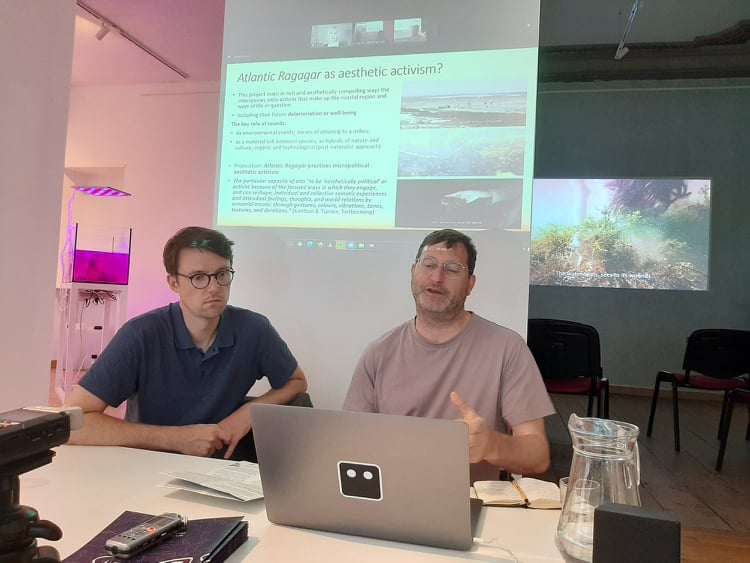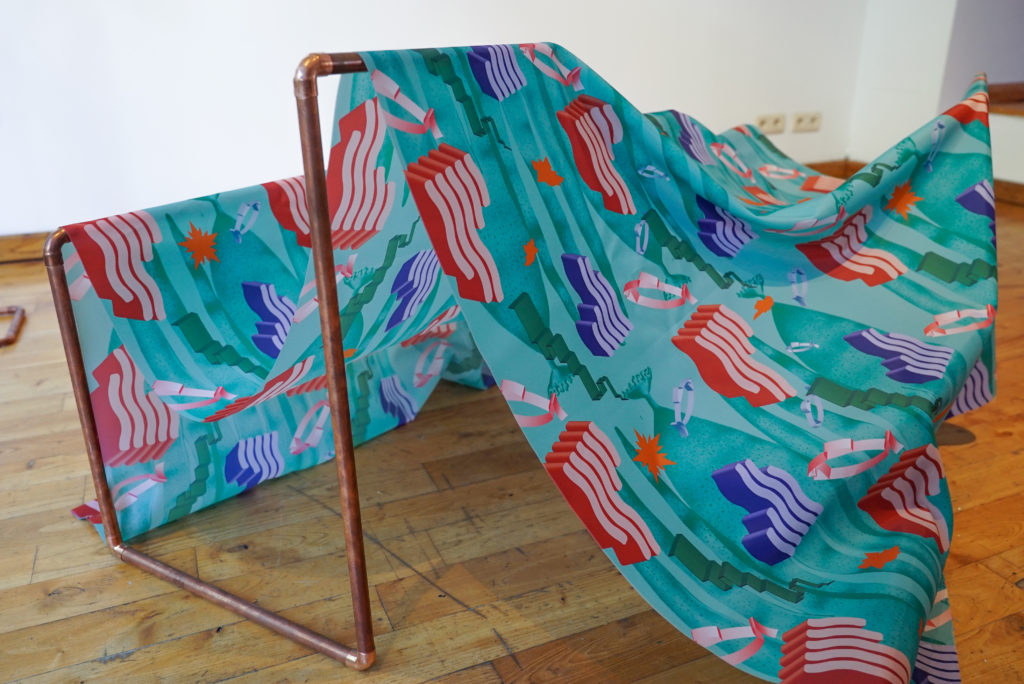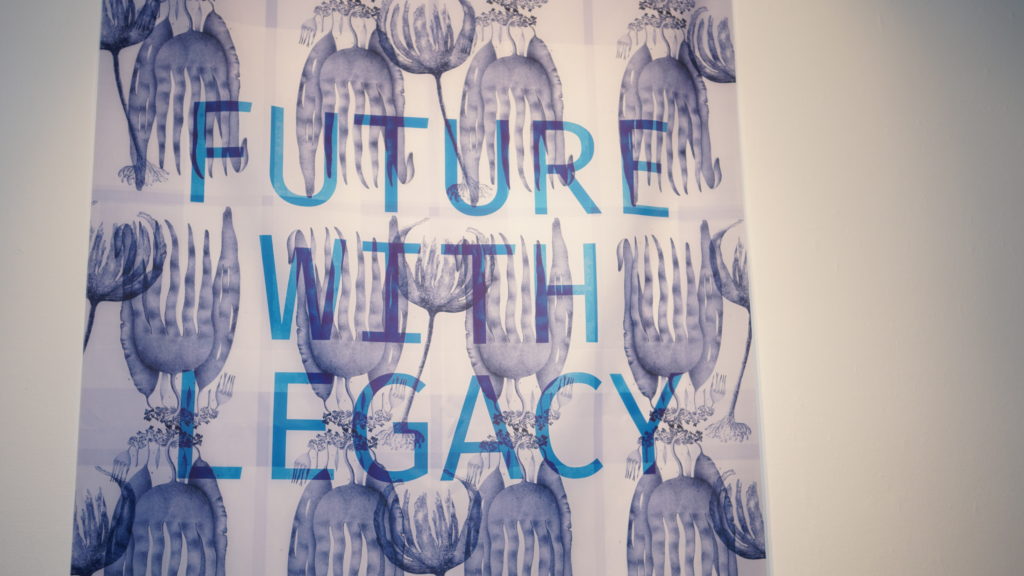ATLANTIC RAGAGAR
GILLES AUBRY – YOUNES BOUNDIR – avec/WITH Abdellah Aboulhamid, Koenraad Bogaert, Soraya El Kahlaoui, Salahddine Kharouai, Zakia Salime, Milla Tiainen
EXPOSITION / PROJECTIONS / PRESENTATIONS / DISCUSSIONS
3.9 – 3.10.2021
EXPOSITION / EXHIBITION 3.9 – 3.10.2021
Le biologiste Younes Boundir et l’artiste Gilles Aubry présentent un ensemble de travaux issus de leur recherche sur les algues et la pollution dans la région côtière de Safi au Maroc. Faisant dialoguer matériaux sonores et vidéo, objets, textiles et un dispositif de culture d’algues, l’exposition “Atlantic Ragagar” est conçue comme une partition d’intra-action écologique. Les relations qui caractérisent l’écosystème du littoral atlantique sont ainsi transposées dans un registre affectif et performatif. L’algue rouge, à la fois ressource nécessaire à la production de l’agar agar et agent de biodiversité, apparaît comme possible modèle pour une redistribution écologique du sensible. L’exposition est accompagnée d’un programme public de présentations, projections, et discussions.
Biologist Younes Boundir and artist Gilles Aubry present a series of works resulting from their joint research on seaweed and pollution on the Moroccan Atlantic coast. Combining audio and video materials, objects, textiles as well as a seaweed culture device, the Atlantic Ragagar exhibition is conceived as a score for ecological intra-action. The relations that characterise the coastal ecosystem are here transposed into a performative and affective domain. Red seaweed, which is both a resource for the production of agar agar and a marine biodiversity agent, provides a possible model for an ecological redistribution of the sensible. The exhibition is accompanied by a public programme of presentations, screenings and discussions.
LE PROJET ATLANTIC RAGAGAR
Partant des travaux scientifiques de Younes Boundir décrivant les effets de la pollution industrielle sur les populations d’algues et l’écosystème marin, le projet “Atlantic Ragagar” aborde la transformation écologique selon une perspective post-naturaliste. Il cherche ainsi à rompre avec les classifications taxonomiques conférant aux humains un statut d’exception, au-dessus des autres espèces. En prêtant attention aux dimensions matérielles, socio-économiques et sensibles des échanges entre humains et environnement, Atlantic Ragagar vise à imaginer des modes de co-existence écologique durables.
Aubry et Boundir examinent d’une part la longue histoire d’interactions entre les populations locales et la vie marine, et de l’autre celle de l’exploitation industrielle de “ressources naturelles”. Connue pour son eau limpide, la plage de Sidi Bouzid près d’El Jadida abrite des douzaines d’espèces d’algues marines, signe d’une riche bio-diversité. Sidi Bouzid est également un site d’exploitation de l’algue rouge (gelidium), utilisée pour la production de poudre d’agar agar destinée aux industries alimentaires et pharmaceutiques. Plus au sud, la ville de Safi héberge un parc industriel de production de conserves de sardine et d’engrais phosphatés. Ces activités génèrent une importante pollution de l’air et de l’eau, avec des conséquences dramatiques pour l’environnement et la santé de la population.
En dialogue avec des habitants, les artistes ont mené une série d’interventions collectives, documentées en vidéo pour l’exposition. “The Binding Effect” rends compte d’un atelier de cuisine avec un groupe de femmes cueilleuses d’algues à Sidi Bouzid. La confection de desserts à base de gelée d’agar agar mène à des conversations sur la vie des algues, la pollution et ses effets, et sur les conditions de travail des femmes cueilleuses. Sur un mode plus expérimental, la vidéo “Atlantic Ragagar” entraine le public dans un processus de transformation sensible et affective. Le film se déploie à travers les vocalises de la performeuse Imane Zoubi, sur la côte dans un premier temps et en studio par la suite, au cours d’improvisations en duo avec Gilles Aubry au synthétiseur. Une partition graphique a été conçue pour ces séances, basée sur les données d’analyse d’eau de mer fournies par Younes Boundir. Une nouvelle figure émerge peu à peu, maouj, un corps aquatique ouvert aux spéculations trans-corporelles et inter-espèces.
Les autres éléments de l’exposition font écho à cette approche initiale, comprenant un dispositif de culture d’algues, des textiles imprimés, des objets en cuivre et en pâte d’agar agar. L’ensemble est présenté comme une partition d’intra-action écologique invitant à une reconfiguration sensible et matérielle du sujet en accord avec l’environnement. De nombreuses références à l’histoire éco-industrielle de la côte Atlantique sont convoquées: emblème de la ville de Safi; logos de sociétés industrielles (phosphate pour l’OCP, sardines pour MIDAV, algue rouge pour SETEXAM); courbe d’évolution du prix du phosphate sur le marché global; taux de concentration de métaux lourds dans l’eau de mer. Ces représentations font l’object de compositions visuelles réalisées en collaboration avec le graphiste Abdellah Aboulhamid: “Ye may extract from the sea” fait référence au verset coranique qui orne l’emblème officielle de la ville de Safi, légitimant ainsi l’exploitation des ressources naturelles à des fins industrielles; “Quantized Sea” figure un environment dont la ‘nature’ semble constituée de particules polluantes et d’algorithmes qui règlent les échanges du commerce mondial; Future with Legacy détourne le slogan publicitaire de l’Office Chérifien des Phosphates (OCP Group) pour suggérer d’autres futurs, hors celui prescrit par l’héritage colonial de l’entreprise; “Ragagarization”, enfin, s’emploie à tout remettre en jeu pour produire de nouveaux corps matériel-affectifs, selon le principe de gélification de l’agar agar.
THE ATLANTIC RAGAGAR PROJECT
Using Younes Boundir’s long-term scientific research on seaweed and pollution as a starting point, the Atlantic Ragagar project engages with ecological transformation from a post-naturalist perspective. It does so by breaking up with the Western taxonomic classification systems that promoted “human exceptionalism” at the expense of other species. By attending to the material, socio-economical, and affective dimensions of the exchanges between humans and the environment, Atlantic Ragagar aims to imagine sustainable ways of ecological co-existence.
Aubry and Boundir examine the long history of interactions between the coast’s local populations and its marine life on the one hand, and the industrial exploitation of “natural resources” on the other. Known for its clear water and its remarkable bio-diversity, the Sidi Bouzid beach near El Jadida hosts dozens of seaweed species. The beach is also known for being a red seaweed (gelidium) exploitation site. Such type of seaweed is used in the production of agar powder for food and pharmaceutical industries. Further south on the coast, the city of Safi hosts an important industrial centre for the production of canned fish and phosphate fertilisers. These activities generate significant water and air pollution, with dramatic consequences for the environment and the health of the population.
In dialogue with the locals, the artists have carried out a number of interventions, which are documented in the exhibition with footage. The Binding Effect is the outcome of a cooking workshop with a group of women who collect seaweed for a living in Sidi Bouzid. Baking agar jelly-based desserts leads to conversations on the life of seaweed, on pollution and its effects and on the working conditions of the women harvesters. Using a more experimental approach, the video Atlantic Ragagar invites the public into a sensory and affective transformation process. The films unfolds through the vocal interventions of the performer Imane Zoubi, first on the beach and later in the studio during improvised sessions with Gilles Aubry on synthesizer. Using scientific data on water pollution from Boundir’s research, a graphic score was designed for theses sessions. A new figure progressively emerges, maouj, an aquatic body open to transcorporeal and interspecies speculations.
The other elements in the exhibition include printed textiles, various copper and agar paste objects, and a living seaweed from the Belgian coast. This heterogeneous configuration is presented as a “score for ecological intra-action”, aiming to facilitate a material and affective reconfiguration of the self, more attuned to the environment. Numerous references to the eco-industrial history of the Safi region are convoked: among others, the flag of the city of Safi; the logos of the local extractive industries (phosphate for the OCP Group, sardines for the MIDAV Group, and red seaweed for the SETEXAM Group); the evolution curve of the phosphate wholesale price on the global market; graphical representations of heavy metal pollution in sea waters. These elements appear transformed in a series of visual compositions designed for the exhibition in collaboration with the graphic designer Abdellah Aboulhamid: Ye may extract from the sea refers to a Koranic verse on the Safi emblem, grounding in religion the city’s important extractive industry; Quantized Sea depicts a marine environment whose ‘nature’ is made of pollution particles and algorithms; Future with Legacy twists the marketing slogan of the OCP Group (National Phosphate Mining Company) in order to point towards new futures, different from the one prescribed by the company’s colonial heritage; Ragagarization, finally, puts everything back into play in an attempt to generate new material-affective bodies, according to the gelation process of agar.
PROGRAMME
3.09.2021, 18h – VERNISSAGE/OPENING
4.09.2021, 15h – 19h30 – PRESENTATIONS & DISCUSSIONS
Quelle justice éco-sociale pour Safi ? (en français) / Which eco-social justice for Safi? (in French)
Avec/with Koenraad Bogaert, Younes Boundir, Salahddine Kharouai, Zakia Salime
Dans son film “Which Climate Justice for Safi ?” (2018), Salahddine Kharouai enquête sur la pollution générée par les usines de phosphate du groupe OCP à Safi et ses conséquences désastreuses. Les invité-es répondent à cette problématique du point-de-vue de leur domaine d’expertise (biologie, sociologie et études de genre) et en débattent avec le public. Comment concilier justice socio-économique et justice environnementale ?
In his short film “Which Climate Justice for Safi ?” (2018), Salahddine Kharouai investigates the pollution caused by the OCP phosphate production plants in Safi, denouncing its disastrous impact on the environment and on the health of the population. The guests will discuss this issue through their field of expertise (biology, sociology and gender studies), and during a public debate. How to reconcile socio-economic and environmental justice?
Performance inter-espèces dans l’art sonore (en anglais) / Interspecies performance in sound art (in English)
Avec/with Milla Tiainen
Spécialiste des questions écologiques dans l’art sonore, la musicologue Milla Tiainen est invitée à répondre au positionnement micro-politique et post-naturaliste du film “Atlantic Ragar” présenté dans l’exposition. Quels sont les enjeux esthétiques et écologiques d’une telle approche, et qu’elles en sont les limites, dans un contexte post-colonial marqué par de fortes inégalités sociales ?
Expert in eco-oriented sound art, the musicologist Milla Tiainen responds to the micro-political and post-naturalist approach of the film “Atlantic Ragar”. What are the aesthetic and ecological stakes of such an art form, and what are its limits, given its postcolonial context characterised by significant social inequalities?
1.10.2021, 19h30 – 22h – “MAROCAINS SANS TERRE”, Projection et discussion / “LANDLESS MOROCCANS”, screening and dicussion
Avec/with Soraya El Kahlaoui
En février 2014 à Rabat, les forces de l’ordre détruisent violement les habitations de la population du Douar Ouled Dlim. Refusant de quitter leur terre, les habitants s’organisent et protestent en réclamant leur droits. Dans son film “Marocains sans terre” (2016), la réalisatrice Soraya El Kahlaoui rends compte de manière poignante de leur lutte. Par son approche spontanée du médium filmique, elle valorise la mémoire collective et individuelle.
In February 2014 in Rabat, police forces forcefully destroyed the homes of Douar Ouled Dlim‘s inhabitants. Refusing to leave their land, the inhabitants held several demonstrations and protests, claiming their right to be relocated. In her film “Landless Moroccans” (2016), director Soraya El Kahlaoui gives a moving account of their struggle. Through her spontaneous approach of the film medium, she values individual and collective memory.
PARTICIPANTS
Gilles Aubry
Artiste, musicien, chercheur et enseignant basé à Lausanne et Berlin. Il crée des installations, films, performances et pièces radiophoniques explorant les dimensions culturelles, écologiques et affectives du son et de l’écoute. Il est diplômé en art sonore de l’Université des Arts de Berlin (UDK) et auteur d’une thèse de doctorat portant sur l’auralité et les voix écologiques au Maroc. Ses travaux ont été présentés dans de nombreux festivals et institutions internationales, notamment à la Biennale de Marrakech (2014), la documenta de Kassel (2017) et au Musée Reina Sofia à Madrid (2020).
Artist, musician, researcher and teacher based in Lausanne and Berlin. He creates installations, films, performances and radio pieces which explore the cultural, ecological and affective dimensions of sound and listening. He has an MA in sonic arts from the Berlin University of the Arts (UDK) and recently completed a doctoral thesis on sound, aurality and ecological voices in Morocco. His works have been presented in numerous international festivals and art institutions, including the Marrakech Biennale (2014), documenta_14 in Kassel (2017), and the Reina Sofia Museum in Madrid (2020).
Younes Boundir
Younes Boundir a obtenu son diplôme de biologiste à l’université Cadi Ayyad de Marrakech en 2015. Spécialisé en biologie marine, phycologie et écologie, il termine actuellement une thèse de doctorat examinant l’impact de la pollution anthropique sur les macro-algues de la côte Atlantique marocaine.
Younes Boundir holds a diploma in biology from the Cadi Ayyad University in Marrakech (2015). Expert in marine biology, phycology and ecology, he is currently completing a doctoral research examining the impact of anthropic pollution on macro-algae on the Moroccan Atlantic coast.
Nasrine Kheltent
Artiste et programmatrice basée à Bruxelles, diplômée en “Art dans l’Espace Public” à l’ARBA-ESA (2017) et de l’Institut Supérieur des Arts et Chorégraphie. Administratrice de la Chambre de l’Art et de la Culture Euro-méditerranéenne, elle accueille des projets artistiques et crée avec Yvon Goossens et Ahmad Aminian un contexte intellectuel, philosophique et socio-politique où se rencontrent culture orientale et culture occidentale.
Artist and curator based in Brussels, she graduated in “Art in Public Space” at the Royal Academy of Fine Arts and the Institut Supérieur des Arts et Chorégraphie. She works as an administrator for La Chambre de l’Art et de la Culture Euro-méditerranéenne, co-initiating projects with Yvon Goossens et Ahmad Aminian in an effort to support cultural exchanges.
Abdellah Aboulhamid
(text manquant)
Koenraad Bogaert
Professeur assistant au département d’étude des conflits et du développement à l’université de Gand. Ses recherches portent sur les changements politiques dans le monde arabe, en relation avec la globalisation, l’urbanisation néo-libérale et l’autoritarisme. Il est l’auteur de nombreuse publications sur les mouvements sociaux au Maroc. Son livre “Globalized Authoritarianism. Megaprojects, Slums and Class relations in Urban Morocco” est paru en 2018 aux presses universitaires du Minnesota.
Koenraad Bogaert is Assistant Professor at the Department of Conflict and Development Studies at Ghent University. His research focuses on the broader question of political change in the Arab World, more specifically in Morocco, in relation to globalisation, neoliberal urbanisation, capitalist uneven development, and social protest. His book, “Globalized Authoritarianism. Megaprojects, Slums and Class relations in Urban Morocco”, was published by the University of Minnesota Pres
Soraya El Kahlaoui
Docteure en sociologie, Soraya El Kahlaoui est chercheuse au département d’étude des conflits et du développement à l’université de Gand. Ses recherches portent sur les résistances des populations situées à la marge du processus d’urbanisation néolibéral au Maroc. Elle est également l’auteure du documentaire “Landless Moroccans” (2016) racontant l’histoire de la tribu Guich Oudaya expulsés de leurs terres à Rabat.
Soraya El Kahlaoui is a postdoc researcher at the Center for Conflict and Development Studies, Ghent University. Her research focuses on land struggle and dispossession, offering an innovative re-reading of the dynamics of social and political transformation in North Africa, more specifically in Morocco and Tunisia. She is also the author of documentary “Landless Moroccans” (2016).
Salahddine Kharouai
Basé à Rabat et Safi, Salahddine Kharouai est journaliste indépendant. Il contribue régulièrement au site d’information “Lakome 2” et est également l’auteur de reportages et d’enquêtes dans le domaine de l’environnement et des droits de l’homme pour le compte de diverses institutions marocaines et internationales.
Independent journalist based in Rabat and Safi. He regularly contributes to the online newspaper “Lakome 2” and is author of several investigations in the field of human rights and ecology commissioned by Moroccan and international institutions.
Zakia Salime
Professeure associée en sociologie et études de genre à l’université de Rutgers (USA). Ses recherches portent sur les questions de genre, de mouvements sociaux et de droit à la terre dans la région MENA et au Maroc en particulier. Elle est l’auteure de “Between Feminism and Islam: Human Rights and Sharia Law in Morocco” (2011) et co-éditrice de “Freedom Without Permission: Bodies and Space in the Arab Revolutions” (2016).
Zakia Salime is an Associate Professor of Women’s and Gender Studies, and Sociology at Rutgers University. She is the author of “Between Feminism and Islam: Human Rights and Sharia Law in Morocco” (2011) and co-editor of “Freedom Without Permission: Bodies and Space in the Arab Revolutions” (2016). She has published extensively on gender, women’s movement, Moroccan Islamism, and youth cultural and political movements in the MENA region, and is currently working on a book manuscript on gender and land rights in Morocco.
Milla Tiainen
Chercheuse et enseignante en musicologie à l’Université d’Helsinki et de Turku en Finlande. Elle est l’auteure de nombreux articles sur la performance musicale, l’art sonore éco-critique et les nouveaux courants de pensée en philosophie néo-matérialiste et post-humaniste. Elle a également publié plusieurs ouvrages musicologiques, dont “Locating the Composer” (2005) et “Becoming Singer” (2012), et co-édité “Musical Encounters with Deleuze and Guattari” (2017).
Dr. Milla Tiainen is Lecturer in Musicology at the University of Turku and Helsinki in Finland. She has published over 50 articles on music performance studies, new materialist and posthumanist thinking, and ecocritical music and sound studies. She is author of Locating the Composer (2005, in Finnish) and Becoming-Singer (2012) and co-editor of Musical Encounters with Deleuze and Guattari (2017).
Commissaire / Curator – Nasrine Kheltent
Conception graphique / graphic design – Abdellah Aboulhamid
Remerciements / Acknowledgements
Pro Helvetia, Fondation suisse pour la culture; Le 18 Marrakech; Untitled Duo.
Ouvert le samedi et le dimanche de 14h à 18h et sur rendez-vous.
Open on Saturdays and Sundays, 14-18h and by appointment.
Fondation pro Helvetia







